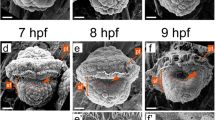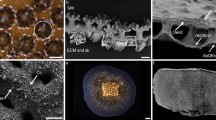Abstract
A novel organ culture system has been developed to study the regulation of statoconia production in the gravity sensing organ in Aplysia californica. Statocysts were cultured in Leibovitz (L15) medium supplemented with salts and Aplysia haemolymph for four days at 17°C. The viability of the system was evaluated by examining four parameters: statocyst morphology, the activity of the mechanosensory cilia in the statocyst, production of new statoconia during culture and change in statoconia volume after culture. There were no morphological differences in statocysts before and after culture when ciliary beating was maintained. There was a 29% increase in the number of statoconia after four days in culture. Mean statocyst, statolith and statoconia volumes were not affected by culture conditions. The presence of carbonic anhydrase in the statocysts was shown using immunohistochemistry. When statocysts were cultured in the presence of 4.0 × 10−4 M acetazolamide to inhibit the enzyme activity, there was a decrease in statoconia production and statoconia volume, indicating a role for this enzyme in statoconia homeostasis, potentially via pH regulation. These studies are the first to report a novel system for the culture of statocysts and show that carbonic anhydrase is involved in the regulation of statoconia volume and production.
Similar content being viewed by others
References
Cao H, Gay CV (1985) Effects of parathyroid hormone and calcitonin on carbonic anhydrase location in osteoclasts of cultured embryonic chick bone. Experientia 41: 1472–1474
Coggeshall RE (1969) A fine structural analysis of the statocyst in Aplysia californica. J Morphol 127: 113–131
Erulkar SD, Maren TH (1961) Carbonic anhydrase and the inner ear. Nature 189: 459–460
Gallin EK, Wiederhold ML (1974) Response of Aplysia statocyst receptor cells to physiologic stimulation. J Physiol (Lond) 266: 123–137
Goldberg DJ (1991) Culturing the large neurons of Aplysia In: Banker G, Goslin K (eds) Culturing nerve Cells. The MIT Press, Cambridge, Mass., pp 155–175
Harada Y (1984) Effects of carbonic anhydrase inhibitor to the otolithic organs. In: Nishimura N (ed) The vestibular organs — morphology, physiology and pathology, Tokyo pp 183–188
Hunter SJ, Schraer H, Gay CV (1988) Characterization of isolated and cultured chick osteoclasts: the effects of acetazolamide, calcitonin, and parathyroid hormone on acid production. J Bone Min Res 3(3): 297–303
Johnson RL, Spoendlin HH (1966) Structural evidence of secretion in the stria vascularis. Ann Otol Rhinol Laryngol 75: 127–138
Kido T, Sekitani T, Yamashita H, Endo S, Masumitshu Y, Shigomori H (1991) Effects of carbonic anhydrase inhibitor on the otolith organ in developing chick embryos. Am J Otolaryngol 12: 191–195
Leibovitz A (1963) The growth and maintenance of tissue/cell cultures in free gas exchange with the atmosphere. Am J Hyg 78: 173–180
Lim DJ, Karabinas C, Trune D (1983) Histochemical localization of carbonic anhydrase in the inner ear. Am J Otolaryngol 4: 33–42
Minkin C, Jennings JM (1972) Carbonic anhydrase and bone remodeling: sulfonamide inhibition of bone resorption in organ culture. Science 2: 1031–1033
Pedrozo HA, Wiederhold ML (1994) Effects of hypergravity on statocyst development in Embryonic Aplysia californica. Hearing Res 79: 137–146
Purichia N, Erway LC (1972) Effects of dichlorophenamide, zinc, and manganese on otolith development in mice. Dev Biol 27: 395–405
Ross M, Pote KG, Cloke PL, Corson C (1980) In vitro 45Ca2+ uptake and exchange by otoconial complexes in high and low K +/Na+ fluids. The Physiologist 23: S129-S130
Stechschulte DJ Jr, Morris DC, Silverton SF, Anderson HC, Vaananen HK (1992) Presence and specific concentration of carbonic anhydrase II in matrix vesicles. Bone and Mineral 17: 187–191
Takumida M, Bagger-Sjoback D, Wersall J, Harada Y (1989) Ultrastructural localization of carbonic anhydrase in the vestibular end organs of the guinea pig. Arch Otolaryngol 246: 56–60
Vicentiis M, Marmo F (1967) Inhibition of the morphogenesis of the otoliths in the chick embryo in the presence of carbonic anhydrase inhibitors. Experientia 24/8: 818–820
Watanabe K, Ogawa A (1984) Carbonic anhydrase activity in stria vascularis and dark cells in vestibular labyrinth. Ann Otol Rhinol Laryngol 93: 262–266
Weiss RE, Wilbur KM (1978) Effects of cytochalasin B on division and calcium carbonate extrusion in a calcareous alga. Exp Cell Res 112: 47–54
Wiederhold ML (1974) Aplysia statocyst receptor cells: intracellular responses to physiological stimuli. Brain Res 78: 490–494
Wiederhold ML (1977) Rectification in Aplysia statocyst receptor cells. J Physiol (Lond) 266: 139–156
Wiederhold ML, Sharma JS, Driscoll BP, Harrison JL (1990) Development of the statocyst in Aplysia californica I. Observations on statoconial development. Hearing Res 49: 63–78
Author information
Authors and Affiliations
Rights and permissions
About this article
Cite this article
Pedrozo, H.A., Schwartz, Z., Nakaya, H. et al. Carbonic anhydrase is required for statoconia homeostasis in organ cultures of statocysts from Aplysia californica . J Comp Physiol A 177, 415–425 (1995). https://doi.org/10.1007/BF00187478
Accepted:
Issue Date:
DOI: https://doi.org/10.1007/BF00187478




